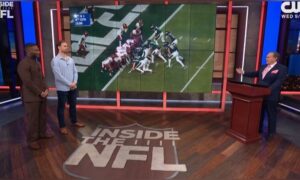When the Tampa Bay Buccaneers turned away from LeGarrette Blount after the 2012 season, they did so holding the belief that they were letting go of a big runner who couldn’t get the tough yards in short-yardage situations.
The statistical evidence from that time period of his career generally supports those claims, as does the fact that the Buccaneers often replaced him with another runner in short-yardage situations.
On third or fourth down and three or less yards to go, the Buccaneers entrusted Blount on just 12 carries—but that was due to his poor performance. He totaled six yards on those 12 carries for an average of .5 yards per attempt, and achieved a first down or a score just a third of the time—fairly abysmal numbers for a ‘big’ back.
As a matter of fact, quarterback Josh Freeman was a far more productive runner than Blount, totaling 65 yards on 34 attempts within the same criteria, achieving a first down or touchdown almost 90 percent of the time.
Who knows what the true story was. Perhaps Blount didn’t have the right technique early on in his career, and he wasn’t given a large enough sample size. The majority of those carries came in his rookie season, with only one coming by the time the Buccaneers drafted Doug Martin in 2012 (who had 15 such carries as a rookie).
This led to a great degree of skepticism when the New England Patriots traded for him, with MassLive’s Nick Underhill questioning the efficacy of bringing him in as a short-yardage back, and speculating that Brandon Bolden would continue in that role.
Due to a variety of factors, Blount ended up taking on a much larger role in New England’s offense than ever envisioned, and that role included split duties in short-yardage situations, primarily with Stevan Ridley, who paced the team with nine carries on third and fourth down with three yards to go or less.
Blount himself totaled seven such carries, and he fared far better than he did earlier in his career in Tampa Bay. He gained 18 yards on those seven carries for 2.57 yards per carry, with an average of 1.57 yards to go per attempt, and he acquired the first down on five of the seven carries.
New England as a team averaged 2.24 yards per carry in such situations, with a conversion rate of 62 percent on 29 attempts.
Primarily an early-down runner, Blount also averaged three yards per carry on first and second down on 19 attempts three yards or less out from a first down or touchdown, while the team as a whole averaged 2.75 yards.
Interestingly, Blount was only given the ball in goal-to-go situations from three yards out or less just three times, scoring once on a first-down play. The majority of his seven scores came from distance, including three from 35 yards or more. The other three came from five, seven, and seven yards out.
According to Underhill, Bill Belichick may have had something to do with his increased efficiency in short-yardage scenarios. According to his article, Blount’s season really started to take off after the head coach advised him about his running style.
“His shoulders are lower and he’s more decisive”, according to Underhill. “Instead of going through guys, he goes over them, putting all 250 pounds of his force behind each blow”. Underhill looked at his Tampa Bay tape in the offseason and didn’t see these things before he emerged as the lead runner in New England.
It was unnatural for Blount, but he’s better for it, and he knows it. “My pad level is definitely one of the places where I’ve improved”, he said. “You just got to keep doing it more often so it becomes a habit”.
That is a habit he’ll be expected to bring with him to Pittsburgh, where he well might be asked to carry quite a bit of the load in short-yardage situations. We’ll see how this compares to the Steelers’ statistics in another article.







